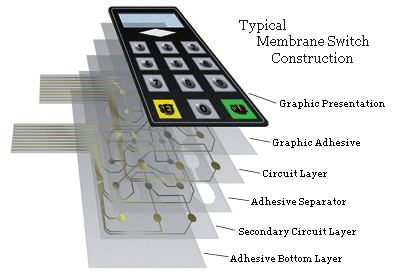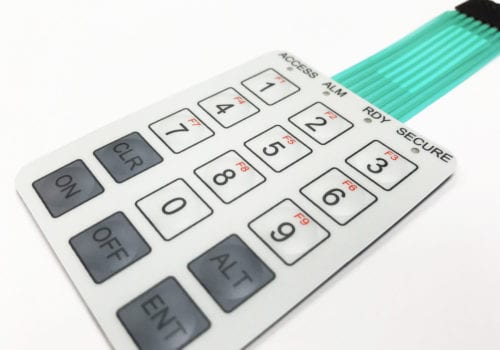An forward-thinking membrane switch manufacturer can offer modern features and materials.
An forward-thinking membrane switch manufacturer can offer modern features and materials.
Blog Article
Everything About Membrane Change: Recognizing Its Style and Capability
When you assume concerning the control interfaces in contemporary tools, membrane buttons often enter your mind. These elements are more than just switches; they mix style and capability perfectly. Recognizing exactly how they function and what makes them effective can alter your perspective on daily electronic devices. There are subtleties to their layout and performance that you may not be mindful of. Allow's explore what collections membrane layer switches besides various other control systems.
What Are Membrane Layer Switches?

Their smooth nature makes them very easy to clean and immune to dirt and moisture, an important feature in several settings. Membrane buttons can also be personalized pertaining to shape, size, and graphics, enabling producers to develop one-of-a-kind interfaces customized to certain products. Plus, they're light-weight and slim, which helps in decreasing the general mass of tools. On the whole, membrane buttons play a significant role in enhancing individual experience across a broad range of applications.
Just How Membrane Switches Work
When you press a secret on a membrane button, it triggers a simple yet efficient mechanism. The leading layer, frequently made of flexible product, presses down onto a conductive layer under it. This activity bridges the gap in between conductive traces, completing an electrical circuit. As quickly as the circuit closes, it sends out a signal to the tool's controller, which translates your input.
You'll discover that the responsive responses differs based on the switch layout, supplying either a soft click or an extra obvious response. As soon as you release the trick, the membrane returns to its initial position, reopening the circuit and stopping the signal. This procedure occurs nearly instantaneously, making certain a responsive user experience.
Membrane switches are popular due to their resilience and resistance to dust and moisture, making them suitable for various applications, from house appliances to medical gadgets. Understanding this procedure aids you value their widespread use.
Key Components of Membrane Buttons
Understanding the key components of membrane switches is essential for realizing their performance and style. At the core, you'll discover the graphic overlay, which provides the aesthetic interface for users. Beneath that, there's a spacer layer that divides the circuit layers, making sure that they don't make call till pressed. The circuit layer is where the magic occurs; it contains conductive traces that finish the circuit when you press the switch. Another crucial element is the sticky backing, enabling the switch to stick to surface areas firmly. The safety layer shields versus environmental elements and put on, expanding the button's life expectancy. Each component plays a substantial function in guaranteeing reliable efficiency and customer interaction. By recognizing these components, you'll gain understanding into how membrane switches over run and their relevance in numerous applications.
Materials Used in Membrane Change Layout
The efficiency and durability of membrane layer switches greatly depend upon the materials utilized in their style. You usually encounter polyester and polycarbonate as primary substrates because of their superb toughness and adaptability. These materials withstand scrapes and chemicals, making them excellent for demanding environments.
The conductive layers commonly utilize silver or carbon, chosen for their dependability and conductivity. membrane switch manufacturer. Silver offers remarkable efficiency, while carbon is an affordable alternative. For the overlay, you could consider a matte or shiny coating, depending upon your aesthetic demands and user experience
Adhesives play a crucial role as well; they bond layers securely and guarantee durability. Make sure to choose adhesives that stand up to ecological aspects like temperature level and moisture. Don't ignore the value of his comment is here a good printing strategy for graphics, as it enhances both performance and visual appeal. Selecting the right materials will certainly guarantee your membrane switch stands the test of time.
Style Factors To Consider for Membrane Buttons
While creating membrane buttons, it's vital to take into account various factors that affect their functionality and user experience. Start by concentrating on the design and button dimension; make specific they're instinctive and simple to browse.
Do not forget the graphic style; clear labeling and color comparison are substantial for presence. Validate your design suits environmental variables, like moisture or temperature variations, which could impact performance. Lastly, bear in mind the value of testing prototypes with genuine individuals to gather feedback and make needed modifications. This iterative procedure helps you fine-tune the style, verifying it fulfills both useful and visual needs successfully. By carefully taking into consideration these elements, you'll create a membrane button that improves functionality and complete satisfaction.
Applications of Membrane Buttons
Membrane switches are flexible elements located in numerous applications, from commercial devices to customer electronics. You'll see their influence in machines that need durable interfaces and in tools that take advantage of sleek designs. Comprehending these applications aids you appreciate the functionality and practicality of membrane switches in everyday modern technology.
Industrial Devices Usage
When you're wanting to boost the performance of industrial equipment, membrane switches use a reputable remedy that combines resilience with straightforward design. These buttons are excellent for extreme atmospheres, offering resistance to dust, moisture, and chemicals. You'll discover them in control panels for making investigate this site equipments, cooling and heating systems, and medical tools, where accuracy and responsiveness are crucial. Their reduced profile indicates they fit effortlessly right into various equipment, saving valuable room while preserving simplicity of usage. With customizable graphics and backlighting alternatives, you can produce an instinctive interface for operators, improving effectiveness and safety and security. Plus, their long lifespan decreases maintenance expenses, making them a smart financial investment for your industrial applications. Embrace membrane layer switches to enhance your operations and enhance total efficiency.
Consumer Electronic Devices Integration
In the domain of consumer electronics, membrane layer switches play a crucial role in improving customer interaction and tool performance. Membrane layer buttons additionally assure resilience and resistance to dust and dampness, prolonging the life-span of your electronics. By picking membrane layer buttons, you enhance not just the functionality but additionally the style of your tools, making day-to-day communications smooth and delightful.
Benefits and Negative Aspects of Membrane Layer Switches
While membrane layer buttons use a variety of benefits, they likewise come with some drawbacks that you must think about. One significant advantage is their small style, making them ideal for space-constrained applications.

Membrane buttons can have a much shorter lifespan contrasted to mechanical switches, specifically under hefty use. They can likewise be less responsive, which might influence customer feedback throughout operation. Stabilizing these pros and cons will help you establish if membrane layer buttons are the appropriate fit for your task.
Regularly Asked Concerns
Exactly How Lengthy Do Membrane Layer Changes Normally Last?
Membrane layer switches typically last in between 5 to ten years, depending on use and environmental problems. You'll desire to evaluate factors like wear, exposure to dampness, and temperature fluctuations to gauge their longevity properly.
Can Membrane Layer Changes Be Customized for Details Designs?
Yes, you can personalize membrane layer switches to fit particular styles (membrane switch manufacturer). You'll have the liberty to pick colors, shapes, and designs that match your task's demands, guaranteeing they mix perfectly with your general visual
What Is the Cost Variety for Membrane Switch Over Production?
The cost variety for membrane button production generally drops in between $1 and $10 per system, depending on variables like design complexity, quantity, and materials. You can obtain quotes from suppliers to locate the most effective option.

Are Membrane Layer Switches Waterproof or Immune?
Membrane switches can helpful resources be made to be waterproof or resistant, depending on materials used and construction techniques. If you need them for wet atmospheres, assure you define those demands throughout the style procedure.
Exactly How Do Membrane Layer Changes Contrast to Conventional Buttons?
Membrane buttons are generally thinner and extra flexible than standard switches, supplying a streamlined layout. They're frequently simpler to clean up and integrate, but could not give the responsive responses you're used to with mechanical choices.
Conclusion

Report this page